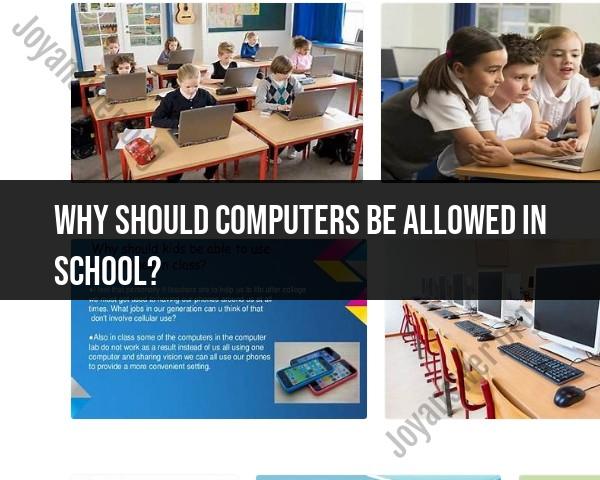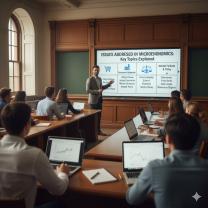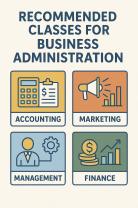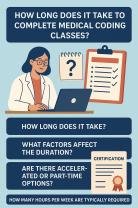Why should computers be allowed in school?
Allowing computers in schools can provide numerous educational benefits by fostering learning through technology. Here are several reasons why computers should be allowed in schools:
Access to Information: Computers provide students with access to a vast amount of information through the internet. This can enhance research skills and expose students to a wide range of educational resources, including articles, multimedia content, and online databases.
Digital Literacy: Integrating computers into the curriculum helps students develop digital literacy skills. This includes the ability to use and navigate digital tools, evaluate online information critically, and understand the basics of coding and programming.
Enhanced Learning Materials: Computers allow for the use of digital textbooks, e-books, and interactive learning materials. These resources can be more dynamic and engaging than traditional printed materials, catering to diverse learning styles.
Personalized Learning: Computers enable adaptive learning technologies and personalized educational software. Students can receive tailored instruction based on their individual needs, progress at their own pace, and practice concepts until mastery is achieved.
Skill Development: The use of computers in schools can help students develop essential skills for the 21st century, such as critical thinking, problem-solving, collaboration, and creativity. Educational software and interactive platforms often incorporate activities that promote these skills.
Preparation for the Future: Integrating technology into education prepares students for the technologically driven world they will face in their future careers. Familiarity with computers and digital tools is increasingly important in various professions.
Efficiency in Teaching and Learning: Computers streamline administrative tasks for teachers, such as grading, lesson planning, and communication with students and parents. This efficiency allows educators to focus more on teaching and providing individualized support to students.
Collaborative Learning: Computers facilitate collaborative learning experiences. Students can work on projects together, share documents, and collaborate on presentations, fostering teamwork and communication skills.
Multimedia Learning: Computers enable the use of multimedia elements in education, such as videos, animations, and simulations. Visual and interactive content can make complex concepts more accessible and enhance overall understanding.
Global Connectivity: Computers allow students to connect with peers, experts, and educational communities globally. Virtual collaborations and online discussions open up opportunities for cultural exchange and diverse perspectives.
Remote Learning Opportunities: Computers provide the infrastructure for remote and online learning, allowing students to access educational resources and participate in classes from anywhere, especially during times when physical attendance is challenging.
It's important to note that successful integration of computers into schools requires thoughtful planning, teacher training, and consideration of issues such as equitable access to technology and internet safety. Additionally, balancing screen time with other forms of learning is essential for a well-rounded education.
Computers in the Classroom: Powering Up Education
In today's tech-driven world, computers are no longer just tools for entertainment and communication; they have become powerful learning resources with the potential to revolutionize education. Let's explore why computers deserve a place in classrooms and how they can contribute to a richer, more engaging learning experience for students.
1. Why Computers? Supercharging Education:
Accessibility to Information: The internet opens doors to a vast library of knowledge, allowing students to research any topic in-depth, access multimedia resources, and explore diverse perspectives beyond textbooks. Imagine students using Google Earth to virtually tour historical sites or delve into interactive simulations of scientific phenomena.
Personalized Learning: Educational software and online platforms provide personalized learning pathways, adapting to individual student needs and learning styles. Imagine students mastering math concepts at their own pace with adaptive learning apps or receiving immediate feedback on their writing through online grammar checkers.
Enhanced Engagement and Motivation: Interactive tools like digital whiteboards, educational games, and virtual reality experiences can transform passive learning into active exploration and discovery, keeping students engaged and motivated. Imagine students manipulating 3D models of molecules in chemistry class or creating multimedia presentations for history projects.
Development of Essential Skills: Using computers in the classroom fosters critical thinking, problem-solving, collaboration, and communication skills. Imagine students working together on online projects, analyzing data in spreadsheets, or creating presentations to showcase their learning.
Preparation for the Future: Technology proficiency is no longer optional; it's essential for success in the 21st century workforce. Integrating technology into the curriculum equips students with the digital literacy skills they need to thrive in a tech-driven world.
2. Educational Advantages for Students:
- Deeper Understanding: Interactive simulations, visualizations, and multimedia resources can make complex concepts more tangible and help students grasp them more deeply. Imagine students understanding the water cycle through an interactive simulation or visualizing the solar system through a virtual reality experience.
- Improved Research Skills: Access to online databases, academic journals, and primary sources allows students to develop strong research skills, learn to critically evaluate information, and form their own conclusions. Imagine students using online research tools to investigate historical events or analyze scientific data from around the world.
- Enhanced Creativity and Communication: Digital tools like presentation software, video editing tools, and online platforms provide students with avenues to express themselves creatively and share their ideas effectively. Imagine students creating animations to explain scientific concepts or collaborating on multimedia presentations for history projects.
- Global Connection and Collaboration: Online platforms and video conferencing tools connect students with their peers around the world, fostering cultural exchange, collaborative projects, and diverse perspectives. Imagine students participating in online debates with students from different countries or collaborating on environmental projects with international teams.
3. Ensuring Responsible and Effective Computer Use:
While computers offer immense benefits, responsible and effective usage is crucial. Here are some ways schools can achieve this:
- Clear Guidelines and Policies: Establish clear rules and expectations for computer use, including acceptable websites, responsible online behavior, and data privacy.
- Teacher Training: Equip teachers with the skills and knowledge to effectively integrate technology into their lessons, manage classroom technology, and address potential issues.
- Cybersecurity Awareness: Educate students about online safety, cyberbullying prevention, and responsible digital citizenship.
- Monitoring and Filtering: Utilize appropriate software and monitoring tools to filter inappropriate content and ensure student safety online.
- Focus on Quality, Not Quantity: Don't simply replace traditional methods with technology; use it strategically to enhance learning and complement established pedagogical approaches.
By embracing the potential of computers and implementing responsible practices, schools can create dynamic learning environments that prepare students for success in the 21st century. Remember, computers are not magic solutions; they are tools that require thoughtful integration and effective use to truly empower learning.
Let's work together to leverage the power of technology to create a vibrant and effective education system for future generations!












